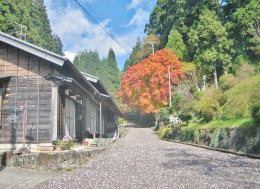|
Nakasendo was the inland road from Kyo to Edo through Omi (Shiga pref.), Mino (Gifu pref.), Shinano (Nagano pref.), Kozuke (Gumma pref.), Musashi (Saitamapref.). In Shinano country which consisted middle zone of the road, it
connected with Hokkoku-kaido, the ways from the coast-areas of the Japan Sea, as well as connected Koshu-kaido to reach Edo.
Then Nakasendo had kept an important position in the military-economic administration by the Shogunate government.
In 1602, the Shogunate monarchy instituted Nakasendo as main road of the Kaido-system which had the strategic-logistic importance. Thereby the Tokugawa dynasty build up the Stage-Town system to manage the key towns along the road under the direct control.
Nakasendo had 69 Stage-Towns including two terminal stages, Nihonbashi and Kusatsu. At both stage the road connected with Tokaido which ran from Edo to Kyo along coasts of the Pacific Ocean.
⇒Reference note about countries and provinces in Old Japan
◆Mountain-road in Shinano◆
Coming over Usui ridge pass Nakasendo got into Shinano country. Main stage towns people would follow thereafter were Oiwake, Odai, Mochizuki, Wada, Shimosuwa, Shiojiri. And the first Stage-Town of Kisoji was Niekawa.
Kisoji is the way running along the ravine-line surrounded by steep mountains. After leaving Shiojiri, the road is tracing back Naraigawa river on the bottom of the canyon.
Kisoji had 11 Stage-Towns, i.e. Niekawa, Narai, Yabuhara, Miyanokoshi,fukushima, Agematsu, Suhara, Nojiri, Midono, Tsumago, Magome.⇒Picture-map
|

Magome ridge pass in late Autumn:
The old road of Nakasendo repaired.
The road is an inland way.
The houses of the traditional architecture in Kiso area are standing by the road now.
After the ridge pass, people walk along the long way through the ravine.
|
